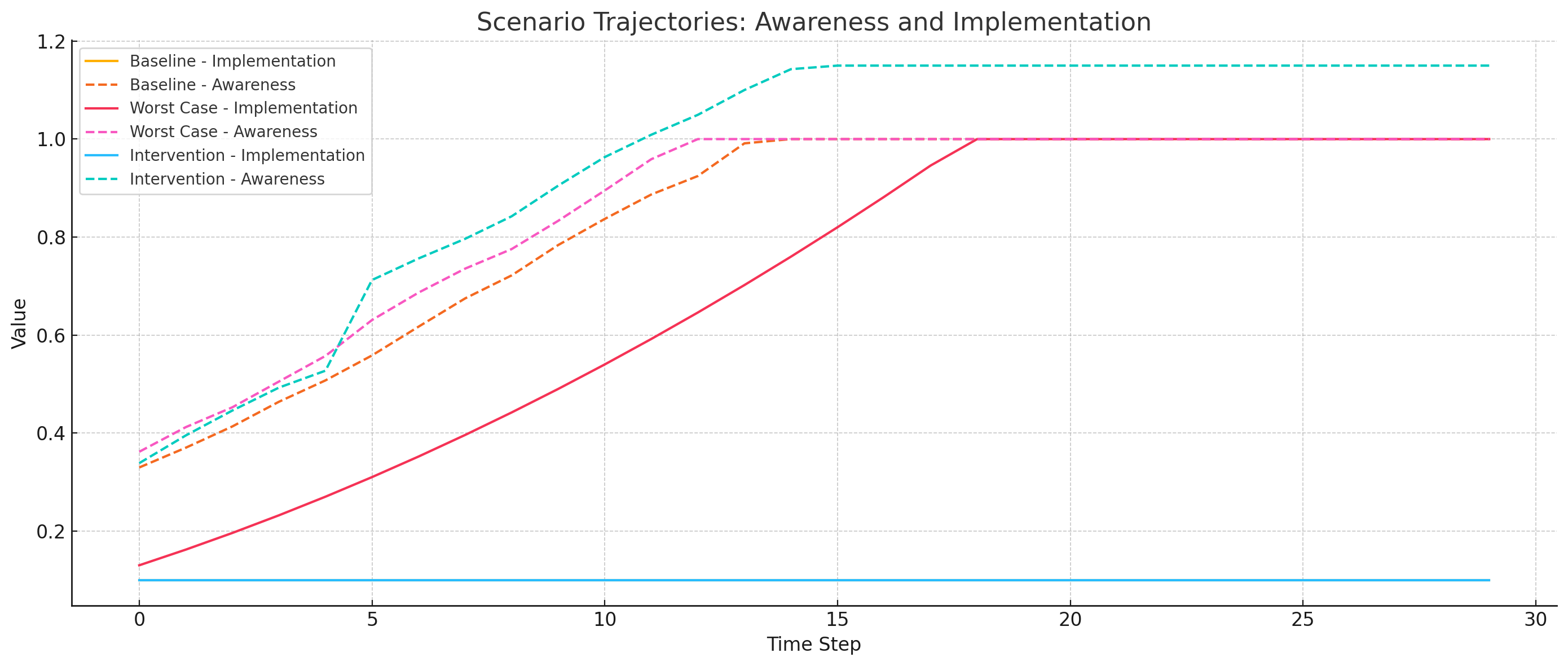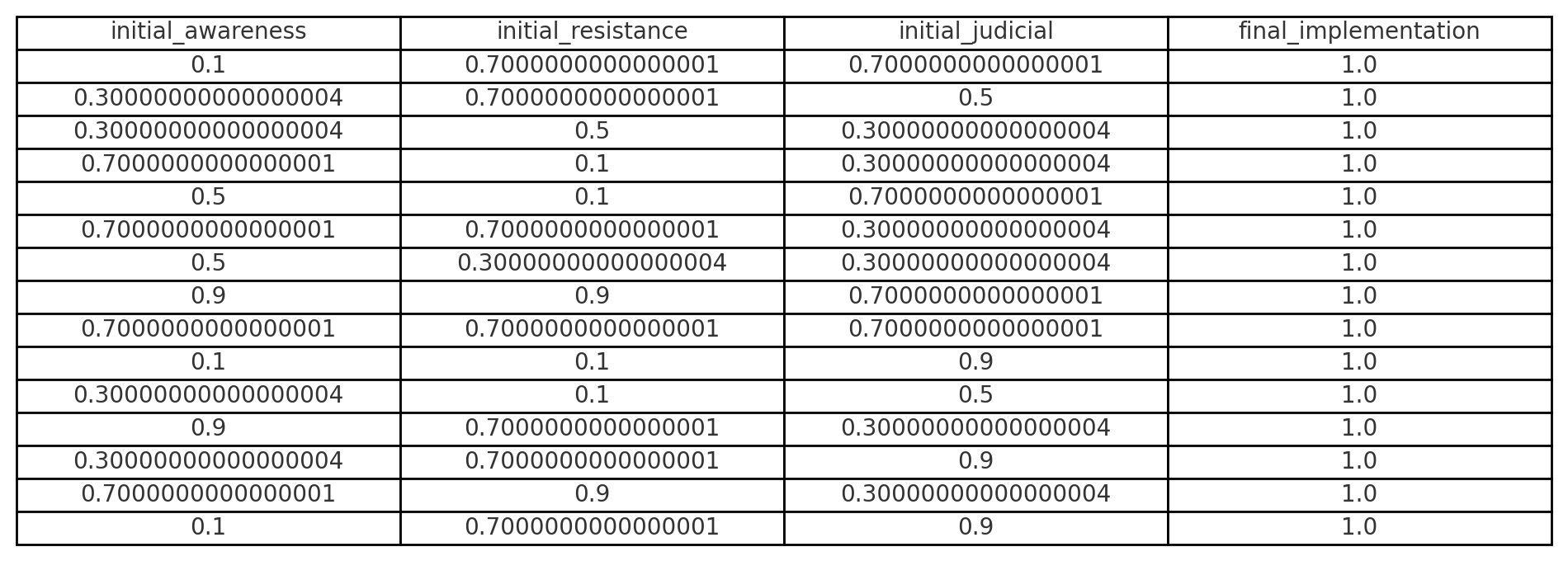Exploring Scenarios of Resistance to Project 2025
1. Executive Summary
This report presents an exploratory simulation using a custom framework called Metakinetics to examine how resistance efforts might influence the trajectory of Project 2025. Project 2025 is a policy blueprint developed by the Heritage Foundation and its allies to restructure the U.S. federal government by expanding presidential power, dismantling regulatory agencies, and embedding conservative ideology across executive institutions.
Disclaimer: Metakinetics is an ad hoc modeling framework created for this exercise. It is not an established methodology and has not been validated against real-world data. All outputs should be interpreted as speculative, not predictive.
We explore scenario dynamics by simulating the interaction of government, legal, civic, and media forces over time. The simulation highlights how public awareness, civil service resistance, and judicial independence can act as key leverage points under various conditions.
2. Introduction
Project 2025 is a conservative policy agenda being incrementally enacted by the Trump administration. This report tests how different resistance pathways might alter its implementation using simulated agent-based dynamics.
3. Methodology
3.1 What is Metakinetics?
Metakinetics simulates system evolution by combining state variables, interacting agents, and macro-forces. At each time step, variables update via conditional rules, noise perturbations, and external constraints.
3.2 Mathematical Framing
System State Sₜ = {V₁…V₇}, where each Vᵢ represents a tracked variable:
- V₁: Presidential outcome ∈ {0, 1}
- V₂: Congressional control ∈ {0.0, 0.5, 1.0}
- V₃: Public awareness ∈ [0, 1]
- V₄: Civil service resistance ∈ [0, 1]
- V₅: Judicial independence ∈ [0, 1]
- V₆: Implementation index ∈ [0, 1]
- V₇: Legal blockades ∈ {0, 1}
General transition: Sₜ₊₁ = T(Sₜ, Aₜ, Fₜ) + ε, where ε ~ N(0, σ²)
3.3 Agent Rules (Simplified)
- Awareness growth: ΔV₃ = α₁ * (1 + 0.5 * V₃) + noise
- Implementation: ΔV₆ = 0.03 + 0.002 * t if V₁ = 1
- Resistance: ΔV₄ = -0.03 if V₆ > 0.7 else +0.01
- Legal blockades: V₇ = 1 if V₅ > 0.7 and t mod 5 == 0
All variables are bounded using a logistic function to prevent invalid values.
4. Scenario Results
4.1 Baseline (Moderate Resistance)
- Public awareness and civil service resistance gradually increase
- Implementation grows slowly to ~0.54
4.2 Worst Case (Unified Government, Weak Institutions)
- Implementation rapidly escalates toward 1.0
- Civil service resistance deteriorates
4.3 Intervention (Legal, Civic, Awareness Boost at Step 5)
- Awareness jump + judicial reinforcement + union action
- Implementation plateaus, resistance strengthens
5. Visualizations
Below is a graph showing implementation and awareness trajectories across all scenarios:

6. Sensitivity Analysis
We varied initial values of awareness, resistance, and judicial independence across 125 simulations. Results showed:
- Implementation remains high without early interventions
- Minor improvements in initial conditions are insufficient on their own
See table below for selected outcomes.

7. Interpretation
- High initial awareness is necessary but not sufficient
- Combined legal, civic, and informational resistance is most effective
- Executive alignment is the dominant predictor of implementation success
8. Limitations
- This is not a forecast: it’s a sandbox for thought experiments
- All parameters are heuristic and unvalidated
- Model behavior is illustrative, not empirical
9. Conclusion
Even speculative models can help surface leverage points and encourage critical planning. Metakinetics, though ad hoc, offers a structure for exploring high-stakes sociopolitical dynamics under uncertainty.
10. Is Resistance Possible?
The thought experiment suggests that resistance to Project 2025 is possible, but only under specific conditions and with sustained, coordinated effort.
The simulations reveal that executive alignment with Project 2025 creates a powerful implementation trajectory. Once in motion, this trajectory accelerates unless countered early by robust civic awareness, institutional resistance, and legal intervention. Mild or delayed actions are rarely sufficient.
However, the model also shows that when public awareness crosses a critical threshold, and legal and bureaucratic systems remain resilient, implementation can be slowed or even plateaued. This implies that strategic resistance is structurally effective when applied early and across multiple fronts.
Resistance is not guaranteed. But it is plausible, actionable, and above all, time-sensitive.
11. Can Project 2025 Be Reversed?
Reversal is much harder than resistance, but not impossible. The model suggests that once a high level of implementation is reached (e.g. above 0.7), rollback becomes increasingly unlikely without a major institutional or electoral shock.
This is because:
- Civil service morale deteriorates as policies embed,
- Legal systems adapt to new precedents,
- Public awareness often fades after initial mobilization,
- Replacement of entrenched personnel is slow and politically costly.
That said, the simulations indicate two possible paths to reversal:
-
Electoral turnover with high legitimacy: A future administration with strong public mandate and institutional support could dismantle Project 2025 reforms, especially if backed by congressional and judicial alignment.
-
Legal invalidation of structural overreach: If key policies are challenged successfully in court, especially those tied to unconstitutional expansions of executive power, portions of the project can be nullified.
In short: reversal is possible, but only under high-pressure, high-alignment conditions. Without that, mitigation and containment are more realistic goals.
Appendix: Full Agent Equations & Parameters
- Awareness: ΔV₃ = α₁ * (1 + 0.5 * V₃) + ε, α₁ = 0.04
- Implementation: ΔV₆ = 0.03 + 0.002 * t if V₁ = 1
- Resistance: +0.01 or -0.03 depending on V₆
- Judicial: V₇ = 1 if V₅ > 0.7 every 5th step
- Noise: ε ~ N(0, 0.01), truncated